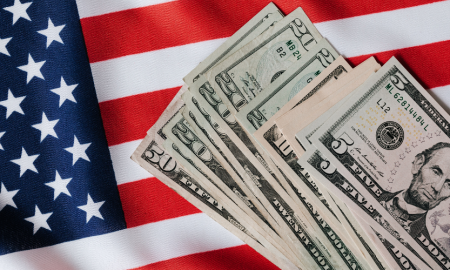
Why American Consumers Are Falling Behind on COVID-Era Debt

When the world was grappling with the health crisis brought on by COVID-19, the U.S. economy faced an equally formidable challenge: A sudden halt in economic activity. To counteract this, the Federal Reserve slashed interest rates, and the government issued stimulus checks. Thus, providing a financial lifeline to citizens nationwide.
This scenario created fertile ground for lenders, who began offering credit with unprecedented ease. However, this led to an unexpected consequence: A significant increase in consumer credit scores.

Cotton Bro / Pexels / As American consumers struggled during COVID, the Federal Reserve offered easy ‘pandemic-era loans.’
Credit Availability During the Pandemic
As the pandemic waged on, and financial relief measures took effect, American wallets received a much-needed respite. With more people qualifying for “good” credit scores, doors swung open for loans and credit lines.
However, as the economy shows signs of recovery and life edges back toward ‘normal,’ many Americans are finding themselves facing a new crisis: Managing the debt they accrued during the pandemic.
The fine print of the lending boom is coming to light. And repayment demands are looming large for numerous borrowers. But what is tipping the scales from manageable to mayhem?

Anna / Pexels / During the pandemic, it seemed that the crisis had introduced a peculiar period of financial prosperity or at least stability.
The Mirage of Perpetual Aid
Initially, the government’s stimulus measures, combined with loan forbearance, painted an optimistic picture. Many assumed additional help would continue, or that the economy would rebound quickly enough to keep up with their new financial obligations.
This assumption has led to a harsh wake-up call as aid dwindles and forbearance periods end.
Plus, with interest rates hitting historic lows during the pandemic, borrowing was more attractive than ever. Yet, as rates normalize, those who tied their fates to variable interest arrangements are facing increasing payments. A scenario many were unprepared for.
Although jobs have returned, they have often come back differently. Sometimes, with lower pay or less security, challenging individuals’ ability to meet their debt obligations. The job market’s volatility has made steady debt repayment a difficult target to hit.
However, despite the bleak outlook, there is a path to financial stability. Borrowers, financial institutions, and policymakers all have roles to play in forging a sustainable recovery.

Tuur / Pexels / As the dust has settled, American consumers are finding it hard to pay back their debts.
The Final Word
As the dust settles on the era of pandemic-induced lending, a complex narrative emerges. The increase in credit scores and borrowing during the pandemic has led to a precarious situation for many American consumers. The path ahead requires a concerted effort to educate, innovate, and legislate our way to a future where credit is not just accessible. But also a stepping stone to genuine financial stability.
The pandemic’s impact on borrowers in the U.S. is a multifaceted issue that sheds light on financial relief and responsibility. While the previous boom in lending opportunities provided immediate relief, the subsequent strain on repayment is a reminder that in the financial ecosystem.
Sure, every boon has its bane. But the focus now shifts to mitigating this new debt challenge through a blend of self-education, lender flexibility, and supportive financial governance.
More in Loans & Mortgages
-
Cap Table Management Firm Pulley Gets Featured on Forbes’s Top 50 Fintech Startups
Pulley, a San Francisco-based cap table management firm, is swiftly gaining momentum, challenging industry giants and redefining the landscape for startups...
February 27, 2024 -
Redefining Your Path: 6 Essential Steps for Career Reengineering
So, you’re at a crossroads in your career, contemplating a change that could redefine your professional path or perhaps dreaming of...
February 19, 2024 -
Unsecured Loans: A Deep Dive
When financial needs arise, borrowing money can provide a solution. But which loan products make the most sense for your situation?...
February 16, 2024 -
How to Get Back to Work After a Career Break | 5 Tried & Tested Tips
Taking a career break can feel like you have hit the pause button on a movie. The world continues to move...
February 10, 2024 -
Small-Cap Stocks Could Be Your Biggest Win in 2024 – Here’s Why
In the stock market, where titans like the S&P 500 often steal the spotlight with their record-breaking performances, it is easy...
February 3, 2024 -
4 Things We Learned From the 2024 Golden Globes: A Night of Surprises and Inspirations
The 81st Golden Globes, held on January 7, 2024, was an event that transcended the boundaries of a typical awards ceremony....
January 26, 2024 -
The Path to Wealth: How 3 Productivity Tips Led Me to Multimillionaire Heights
In the pursuit of success, one often encounters the timeless question: How do successful individuals maintain such high levels of productivity?...
January 20, 2024 -
Exciting Career Horizons in 2024: Is Now Your Moment?
As we step into the vibrant landscape of 2024, a question bubbles up in the minds of many: “Is now the...
January 9, 2024 -
Here Are the Top 5 Nickel Stocks to Buy
As you venture into the intriguing world of investing, there is a shiny sector that deserves your attention: Nickel stocks. First...
December 31, 2023














You must be logged in to post a comment Login